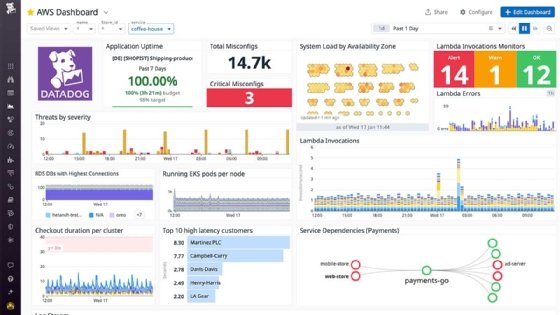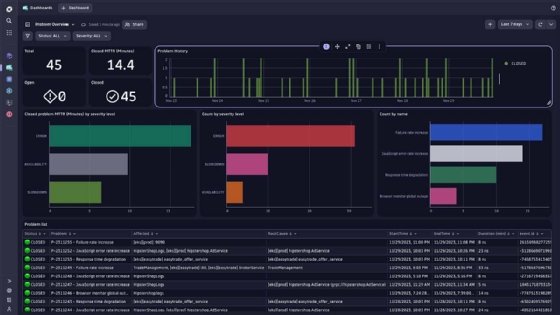Top observability tools for 2025
Observability tools can help developers and IT administrators improve the delivery, performance and customer experience of applications and avoid potential issues.
Many development teams have adopted a microservices architecture that enables them to deploy their applications across distributed environments. Although this makes the applications easier to build, deliver and scale, it can also make it more difficult to track and troubleshoot the components that make up the environment.
Organizations need visibility into these components to understand how their applications behave. For this reason, many have turned to observability tools, which help them monitor their distributed systems and respond quickly to any problems with the application delivery.
What are observability tools?
An observability tool provides a centralized platform for aggregating and visualizing telemetric data that has been collected from application and infrastructure components in a distributed environment. The tool monitors and analyzes application behavior and the various types of infrastructure that support application delivery, making it possible to proactively address issues before they become serious concerns.
An effective observability platform is more than just a monitoring tool. It builds on traditional monitoring capabilities, but it provides deeper insights into the data that can help IT administrators optimize performance, ensure availability and improve the customer experience. To achieve this, most observability tools collect and aggregate three types of telemetry data:
This article is part of
What is observability? A beginner's guide
- Metrics. Measurements of how a service or component performs over time. For example, an observability tool might gather metrics about memory usage, bandwidth utilization, HTTP requests per second or an assortment of other systems.
- Logs. Records of events that occur on a specific system or application. The event information might be recorded as plain text or structured data or in a binary format. Event logs are often the first thing administrators and developers look at when troubleshooting system or application issues.
- Traces. Representational profiles of entire processes as they're carried out across a distributed system. A trace links together the events in a single request or transaction to provide a complete picture of how it flows from one point to the next. For example, traces can show how applications are contending for network and storage resources.
These three types of telemetry data are often referred to as the pillars of observability because of the important roles they play. Metrics, logs and traces provide organizations with the data they need to understand when and why a distributed application is behaving the way it is. With the right observability platform, organizations have visibility into all layers of the application stack, which can help them gain comprehensive insights into their distributed systems over the long term.
Top observability tools in 2025
Several vendors offer observability tools, but it's not always clear how they differ or which ones might provide the most benefits for an organization's particular circumstances. Here are nine of the leading observability tools on the market, presented in alphabetical order.
1. Amazon CloudWatch
Amazon CloudWatch is an observability platform that provides a set of cloud-based tools for monitoring resources and applications hosted on AWS, on-premises systems or hybrid environments. The platform enables administrators to collect and track metrics, logs and traces from Elastic Compute Cloud instances and in-house servers that run either Linux or Windows Server. CloudWatch gives administrators full visibility into application performance, resource utilization and operational health, including infrastructure and network resources.
- Platform. CloudWatch is implemented as an AWS service.
- Coverage. The platform monitors AWS resources and applications, on-premises applications, network connectivity between AWS applications, and the internet connection between AWS applications and end users. CloudWatch can also collect system-level metrics and log data from on-premises databases, servers and OSes.
- Communications. Most AWS services automatically generate metrics that CloudWatch can use when monitoring AWS systems or applications. Amazon also provides the CloudWatch agent for gathering additional metrics from both AWS services and on-premises systems.
- Plans. CloudWatch is available in both a free tier plan and a paid tier plan. The free tier supports only a limited number of operations, although it can still be useful for many types of applications. The paid tier is based solely on usage, with no upfront commitments or minimum fees.
- Free trial. Customers can try CloudWatch by signing up for the free tier.
2. Datadog
The Datadog observability platform offers full visibility into each layer of a distributed environment, with built-in support for more than 800 third-party integrations. The platform provides a single pane of glass for troubleshooting distributed systems, optimizing application performance and supporting cross-team collaboration. Datadog pairs automatic scaling and deployment with intuitive tools that incorporate machine learning for more reliable insights into applications and infrastructure.
- Platform. Datadog is delivered as SaaS.
- Coverage. The platform can monitor infrastructure, applications, databases, network performance and the full DevOps stack, with support for user and network monitoring, synthetic monitoring, and log and incident management.
- Communications. Open source agents running on the monitored systems report metrics and events to the Datadog platform. The agents can run on bare metal or within containers.
- Plans. Datadog offers a wide range of subscription plans, such as Infrastructure, Log Management, Incident Response, APM and Continuous Profiler, and numerous others. Many of these plans are broken down into multiple subplans.
- Free trial. A 14-day free trial is available.

3. Dynatrace
Dynatrace provides an integrated platform for monitoring infrastructure and applications, including networks, mobile apps and server-side services. The platform can also analyze the performance of user interactions with applications and includes an AI-driven causation engine that supports root cause analysis. Dynatrace supports more than 600 third-party technologies and is built on open standards that enable organizations to extend the platform by using the Dynatrace API, SDK or plugins.
- Platform. Dynatrace is typically delivered as SaaS, but the vendor also offers an on-premises option that delivers managed services to the customer's hardware.
- Coverage. Dynatrace can monitor infrastructure, applications, microservices and application security, as well as support digital experience monitoring and business analytics.
- Communications. An agent runs on each monitored host, collecting system, application, network and log data, and sends the data to the Dynatrace platform.
- Plans. The platform supports seven plans: Full-Stack Monitoring, Infrastructure Monitoring, Kubernetes Platform Monitoring, Application Security, Real User Monitoring, Synthetic Monitoring, and Log Management and Analytics.
- Free trial. A 15-day free trial is available.

4. Grafana
Grafana offers a centralized platform for exploring and visualizing metrics, logs and traces. The platform includes alerting capabilities and provides tools for turning time series database data into insightful graphs and visualizations. From a central interface, users can create a rich set of dashboards that display telemetric data from a wide range of sources, including Kubernetes clusters, multiple cloud services, Raspberry Pi devices and services such as Google Sheets.
- Platform. Grafana Cloud is available as a fully managed cloud service. Grafana Enterprise Stack is a self-managed platform that can be implemented on-premises or in the cloud.
- Coverage. Grafana can monitor infrastructure, applications, data sources, microservices and third-party platforms.
- Communications. Grafana's open source agent runs on monitored devices and collects metrics, logs and traces. The agent then forwards the telemetry data to the Grafana platform, whether running in the cloud or on-premises.
- Plans. Grafana Cloud is available in three subscription plans: Free, Pro and Advanced. Organizations must contact Grafana for details about Enterprise Stack plans. Grafana also offers the open source OSS and Enterprise editions, the latter of which is a pared-down version of Enterprise Stack.
- Free trial. Organizations can try out Grafana Cloud through the free service or a 14-day free trial of the Pro plan. Organizations can also download the OSS or Enterprise edition and use it for free.
5. IBM Instana Observability
Instana is an observability platform that can automatically discover and monitor applications across a variety of environments, including microservices and containers, as well as mobile applications. The platform offers upstream and downstream visibility into over 300 application and infrastructure environments, while supporting over 200 domain-specific technologies. In addition, Instana can trace end-to-end mobile, web and application transactions, providing full context across the application stack.
- Platform. IBM offers the Instana back end as a SaaS tool or as a self-hosted system that can be deployed on-premises or in an IaaS environment. Administrators can access the back end through the Instana web interface or through the Instana REST API.
- Coverage. Instana supports a wide range of systems and services, including cloud platforms and services, database platforms, Kubernetes environments, log management solutions, messaging apps, OSes, web platforms and several others.
- Communications. Instana utilizes a single-agent architecture to collect data from participating systems. Each host is configured with one agent, which, in turn, deploys technology-specific sensors that send metrics back to the agent and communicate tracer-related information.
- Plans. Instana comes in two subscription plans: Observability Essentials and Observability Standard. IBM also offers two add-ons: Instana Managed PoPs for synthetic test execution and Logs in context for advanced log ingestion.
- Free trial. IBM offers a 14-day free trial that includes access to all Instana capabilities. Users can also view on-demand videos, register for Instana webinars or book a live demo.
6. New Relic
The New Relic observability platform is made up of multiple tools that provide full-stack monitoring across applications and infrastructure. This includes Kubernetes, browser, mobile, network and synthetic monitoring. The platform also provides log management and error tracking, as well as CodeStream integration, which offers a developer collaboration platform. In addition, New Relic integrates with more than 500 third-party technologies and uses applied intelligence to provide automatic insights into an incident's root causes.
- Platform. New Relic is implemented as SaaS.
- Coverage. New Relic monitors infrastructure, applications, networks, Kubernetes environments and other platforms. It also supports log management, as well as mobile and browser monitoring.
- Communications. Agents installed on hosts or within applications send performance data to the New Relic platform. New Relic also provides native support for OpenTelemetry.
- Plans. New Relic offers four subscription plans: Free, Standard, Pro and Enterprise.
- Free trial. Organizations can try New Relic through the Free plan.
7. ServiceNow Cloud Observability, formerly Lightstep
As of August 2023, the observability tool Lightstep has been rebranded to ServiceNow Cloud Observability, but product and detail functions stay the same for now. The tool is a unified observability platform that provides real-time insights into applications and infrastructure, offering both visibility and context across service boundaries. The platform can automatically detect changes to applications, infrastructure and UX, as well as provide details about their causes. It also offers advanced troubleshooting capabilities that include structured views of the investigation steps. Users can aggregate and visualize data across large-scale operations that incorporate millions of devices, users and customers.
- Platform. ServiceNow Cloud Observability is implemented as SaaS but uses local or cloud-based microsatellites that bridge the monitored components and the tool's platform.
- Coverage. ServiceNow Cloud Observability provides visibility into infrastructure, applications, runtimes, cloud platforms and other third-party services, with support for a wide range of languages, frameworks and platforms.
- Communications. ServiceNow Cloud Observability uses OpenTelemetry launchers, Jaeger agents or Zipkin to collect telemetry data, which is then fed to the microsatellites that communicate with the platform.
- Plans. ServiceNow Cloud Observability offers two subscription plans: Teams and Enterprise.
- Free trial. No free trial exists currently
8. Splunk AppDynamics
Splunk AppDynamics is a performance monitoring and analytics platform that provides real-time visibility into applications and infrastructure across hybrid environments. It helps organizations proactively detect, diagnose and resolve issues using detailed insights into application performance, user behavior and the health of the underlying infrastructure. When Cisco acquired Splunk in 2024, AppDynamics became part of the Splunk Observability portfolio. Splunk AppDynamics uses machine learning to optimize performance and improve UX.
- Platform. Splunk AppDynamics is offered as an on-premises platform and as SaaS.
- Coverage. The platform can monitor many types of applications, including microservices, cloud-native and legacy applications. It provides visibility into cloud environments, including AWS, Azure and Google Cloud, as well as on-premises applications and hybrid environments. AppDynamics integrates with Kubernetes and Docker, as well as databases, web servers and network infrastructure.
- Communications. AppDynamics offers several methods for ingesting data from applications and systems. It uses agents, including AppDynamics Java, .NET, Node.js and other language-specific agents, to collect performance data. AppDynamics supports integration with cloud-native services, and it offers automatic application discovery to help map complex environments.
- Plans. Splunk AppDynamics offers multiple pricing tiers, including a basic plan for small teams and more comprehensive plans for enterprise needs. The pricing is typically based on the number of nodes or servers being monitored, and the platform also offers flexibility with options such as application monitoring and infrastructure monitoring bundles.
- Free trial. A 15-day free trial is available. Users can also request a demo or engage with an expert for a more personalized walkthrough of the platform's capabilities.
9. Sumo Logic
Sumo Logic is a log analytics SaaS platform built on a cloud-native, distributed architecture. The platform offers a scalable, multi-tenant environment for ingesting structured and unstructured logs. Customers can monitor, troubleshoot and secure their cloud and on-premises applications across a variety of environments and systems, including microservices, containers and Kubernetes. The platform uses machine learning and advanced analytics to ingest and analyze system data, while providing continuous infrastructure and compliance monitoring.
- Platform. Sumo Logic is delivered as SaaS.
- Coverage. The platform can ingest log data from cloud providers, such as AWS, Azure and Google Cloud, as well as from container environments, such as Kubernetes and Docker. The platform can also pull log data from web servers, database servers, productivity tools and security applications.
- Communications. The platform provides several options for ingesting log data from source systems. To monitor cloud services, customers can use the agentless collectors hosted in the cloud by Sumo Logic. For all other environments, they can use one of two agents: the OpenTelemetry Distribution agent or the Installed Collectors agent, which is the more lightweight of the two.
- Plans. Sumo Logic offers three plans: Free, Essentials and Enterprise Suite. Sumo Logic also offers the Flex plan, in which pricing is based on insights rather than the amount of ingested data.
- Free trial. A 30-day free trial is available. Users can also view interactive demos or request a live demo from a Sumo Logic expert.
How to choose the best observability tool for your business
Selecting an observability tool is no small task. Decision-makers must choose from a growing number of platforms whose differences aren't always apparent. At the same time, they must determine which tools best meet their specific needs -- both now and in the foreseeable future -- and are flexible enough to accommodate changing business requirements. When evaluating observability platforms, decision-makers should consider the following guidelines:
- The platform should be easy to deploy, manage, automate multiple processes and provide an interface that's intuitive and easy to navigate.
- The vendor should provide ongoing support that includes timely updates and product improvements on a regular basis.
- The platform's underlying infrastructure and supporting components should be reliable and provide easy scalability without adding undue overhead to IT operations.
- The platform should support and easily integrate with the languages, frameworks, platforms and tools that an organization is already using or plans to use to support its distributed applications.
- The platform should provide organizations with comprehensive, real-time visibility into their monitored applications and infrastructure, while delivering the data necessary to make critical business decisions.
- Administrators should be able to easily access telemetry data, reports, visualizations, KPIs and other information from a centralized dashboard to gain real-time insights into the collected data quickly and easily.
- The platform should have the ability to generate alerts and notifications that ensure critical information gets to the right people as quickly as possible.
- The platform should incorporate AI, machine learning, advanced analytics or other advanced technologies to help better use the collected telemetry data.
- The platform should offer predictable and competitive pricing that lets customers operate within budget.
Ultimately, an observability tool must be able to help organizations optimize application delivery, improve the customer experience and meet their business goals. To this end, decision-makers should evaluate prospective platforms based on the tools, processes and infrastructure they use to support their distributed applications, looking for platforms that help them gather and understand their telemetry data. Only then are they able to implement an observability strategy that can help them meet the challenges that come with modern applications.
Editor's note: While researching observability tools extensively, TechTarget editors focused on leading characteristics, such as telemetry capabilities, open source optioning and security. Our research included data from user review analysis and reports from respected research firms, including Gartner. This article was originally written by Robert Sheldon in 2022. TechTarget editors reviewed and updated it in February 2025.
Robert Sheldon is a freelance technology writer. He has written numerous books, articles and training materials on a wide range of topics, including big data, generative AI, 5D memory crystals, the dark web and the 11th dimension.






